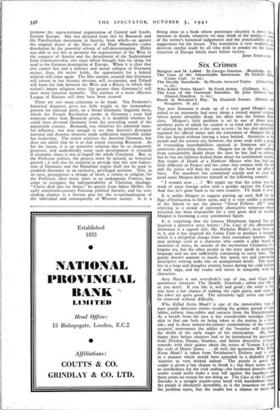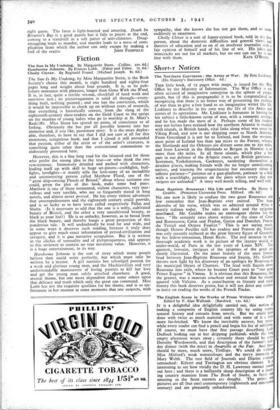Six Crimes
THE new Simenon is made up of a very good • Maigret story yoked to an extremely bad story about a retired master criminal whose patent absurdity drags the affair into the Sexton Blake class. Maigret's little problem is set in one of those misty northern ports of which his creator is so fond and his technique of solution by attrition is the same as ever ; he has also apparently regained his official status and the retirement of Maigret Sits It Out has lapsed without leaving a trace behind. Attractive as the people and the scenery are, however, the story ends with a group of resounding improbabilities unusual in Simenon and of a somewhat disturbing character. Maigret has in the past suffered from considerable doubt about the laws he has had to enforce, but he has not hitherto kicked them about for sentimental reasons. Any reader of Death of a Harbour Master who has had any little difficulty in France and has come into contact with the law and the police will find the conclusion of the book an affair el farce. The murderer has committed suicide and to clear his good name Maigret delivers himself of the following remark:
" I wonder now . . .? We might say that the crime was the Work of some foreign sailor with a grudge against the Captain. And that he's gone back to his own country. I'll think it over.°
It is unlike Maigret to suggest putting up such fluff for the Page d'Instruction. to blow upon, and it is very unlike a member Of the sarete to use the phrase " Good Fellows All " when referring to a crowd of extremely obstructive witnesses whose reticence has been responsible for a very great deal of trouble Maigret is becoming a cosy sentimental figure.
It is surprising that the famous Himalayan legend has not inspired a detective story before:' The Case of the Abominable Snowman is a superb title, Mr. Nicholas Blake's story lives up to it, and it has inspired the Crime Club to produce a wrapper which is a delightful change from their customary horrors. Oat may perhaps cavil at a character who combs a silky beard in moments of stress, he smacks of the mysterious Chinaman of a bygone era, but the other people in the story speak in authentic language and are not sufficiently convincing to carry him. The puzzle doesn't amount to much, but speed, wit and convincing descriptive writing make this an unimportant detail. The action lies in a large and draughty country house during the cold weather of early 1940, and the reader will shiver in sympathy with the characters.
Asey Mayo is not everybody's cup of tea, and Cape Cod quaintness saturates The Dewily Sunshade ; either you like it or you don't. If you like it, well and good ; the story is f you have a fair chance of making the right guess, and some the jokes are quite good. The extremely ugly cover can luckily be removed without difficulty.
Who Killed Netta Maul ? is one of the: remorseless type pure puzzle detective stories recalling the golden period of tide- tables, railway time-tables and extracts from the Encydopa As a breath from the past it has considerable nostalgic ch akin to that one feels on being taken to the station in a ho cab ; and in these minute-by-minute examinations of the vario suspects' movements the addict of the 'twenties will recap the thrills of the early stages of his intoxication. Ah, happy days before chapters had to be introduced by quotati from Dryden, Donne, Southey, and before detectives swap remarks with their quarry about the essays of Vernon Lee the style of Henry James . . . ih well, the quotation Who Vie Netta Maul ? is taken from Swinburne's Dolores and is used in a manner which would have appealed to a diabolist of th 'nineties as very wicked indeed. The puzzle is good, the reader is given a fair chance to break it ; but there seems to no justification for the trick ending—the hardened detective-story reader could easily make a true bill against the murderer there seems no reason for not doing so. The Case of the Cols Suicides is a straight puzzle-story laced with knockabout faro the puzzle is absolutely incredible, as is the insurance on wili the problem turns, but the reader has a_ chance to make
right guess. The farce is light-hearted and amusing. Death In Botanist's Bay is a good puzzle but it falls to pieces at the end, coming to a standstill in a soft patter of anti-climaxes. Drug- smuggling leads to murder, and murder leads to a mess of com- plication from which the author can only escape by making a



























 Previous page
Previous page